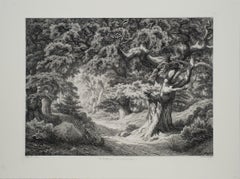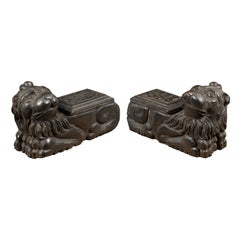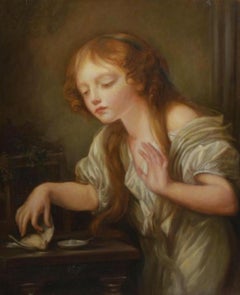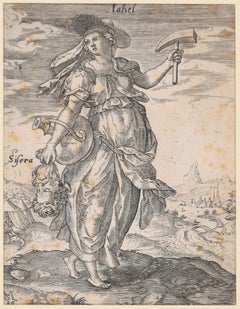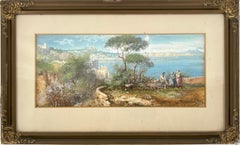Renaissance Art
to
122
75
117
28
28
39
Overall Width
to
Overall Height
to
76
35
121
55
1
1
1
2
94
3
3
2
17
114,432
65,096
55,001
27,063
14,920
9,371
6,542
5,779
4,193
3,054
2,582
2,327
2,250
719
182
68
10
230
131
102
100
96
51
46
28
28
19
18
12
9
7
7
6
5
5
5
5
75
67
51
30
24
93
5
2
47
29
195
75
Style: Renaissance
Las Meninas
Located in Brooklyn, NY
This etching reproduction of Las Meninas was produced by the Louvre Museum, meticulously capturing the essence of Velázquez’s most iconic masterpiece. Printed using the calcolgraphie...
Category
16th Century Renaissance Art
Materials
Etching
$320 Sale Price
20% Off
Le Charlemagne (Foret de Fontainebleau)- 1991
By Eugene Blery
Located in Brooklyn, NY
This reproduction of Eugène Bléry's etching Le Charlemagne depicts the Forêt de Fontainebleau, a renowned forest located south of Paris. The print is produced by La Calcographie du L...
Category
Late 17th Century Renaissance Art
Materials
Etching
$248 Sale Price
38% Off
Antique Italian sculptor - Pair of 18th century wooden sculptures - Lions
Located in Varmo, IT
Pair of carved wood sculptures - Archaic lions. Italy, 18th century.
30 x 12 x 17 cm high each.
Made entirely of finely carved wood.
- This item is sold with a certificate of aut...
Category
Late 18th Century Renaissance Art
Materials
Wood
The Dead Bird, Large Oil Painting on Canvas by Louvre Copyist
Located in Cirencester, Gloucestershire
"The Dead Bird"
After Jean-Baptiste Greuze (1725-1805)
oil painting on canvas, late 20th century
from the studio of Dagher, Paris (read notes below), stampe...
Category
18th Century Renaissance Art
Materials
Canvas, Oil
Jale with the Sisera's Head - Original Etching by M. Greuter
By Matthaeus Greuter
Located in Roma, IT
Jale with the Sisera's Head is a copper engraving on laid paper in 1586 by the German engraver Matthaeus Greuter.
Representing one of the terrible heroines of the Old Testament, Gia...
Category
16th Century Renaissance Art
Materials
Etching
View in Summer of Napoli, Italy
Located in Soquel, CA
View in Summer of Napoli, Italy
Well executed pleinair painting of a hill over looking the Bay of Napoli, Italy. done at the turn of the century in ...
Category
1910s Renaissance Art
Materials
Watercolor, Gouache, Laid Paper
$1,080 Sale Price
20% Off
The Black Silk Dress (Anaïs).
Located in Storrs, CT
The Black Silk Dress. 1927. Etching. Fletcher catalog 58 state .ix (published state). 8 3/4 x 6 1/4 (sheet 14 1/2 x 9 1/8). Edition 76 in this state; total 111 proofs). Exhibited at...
Category
1920s Renaissance Art
Materials
Etching
$1,800 Sale Price
28% Off
Millet-Donna Che Si Togue La Camilia/Woman removing her shirt Renaissance
Located in Brooklyn, NY
This exquisite reproduction of Donna Che Si Toglie La Camicia by Jean-François Millet captures the delicate intimacy and timeless beauty of one of the artist's most evocative works. ...
Category
1950s Renaissance Art
Materials
Lithograph
L'annonciation
By Leonardo da Vinci
Located in Brooklyn, NY
This reproduction of Leonardo da Vinci’s "Annunciation" is an etching created from the original plate and issued as a restrike by the Louvre Museum collection in Paris. The piece pre...
Category
17th Century Renaissance Art
Materials
Etching
$216 Sale Price
20% Off
Painted Wood Tavolette Book Cover Binding The Biccherna Aesthetic Siena Tuscany
Located in Sutton Poyntz, Dorset
Icilio Federico Joni.
Italian ( b.1866 - d.1946 ).
Painted Gesso, Gilt & Wood Tavolette Book Cover Binding In The Sienese Biccherna Aesthetic.
Book Cover size 11 inches x 8.1 inches ( 28cm x 20.5cm ).
Frame size 16 inches x 13 inches ( 40.5cm x 33cm ).
Available for sale; this painted gesso and gilt “tavolette” wooden book cover in the Biccherna aesthetic is by Icilio Federico Joni.
The book cover is mounted and supplied in a contemporary black Tulip Wood frame (which is shown in these photographs) which is glazed with non-reflective Tru Vue UltraVue® UV70 glass. The wooden book cover is curved and float mounted giving a wonderful 3D depth to its presentation.
The gesso and painted surfaces have benefitted from professional restoration which was performed on our instruction, supervision and approval.
This antique book cover is in very good condition, commensurate with its age.
The frame presentation is new and in excellent condition. Combined, it wants for nothing and is supplied ready to hang and display.
The story of these panels and of their artist is fascinating, and begins in 13th century Siena:
The Biccherna was the person who held the position of Magistrate of Chancellery of Finance from the 13th to the 14th century for the republic and the city of Siena, in the Tuscany region of Italy. The records of that office were very important because Siena was one of the earliest and most significant banking centres in Italy, and indeed in Europe. It became the fashion to keep banking and taxation records of the region in large books with painted leather covers. These were originally made from wood and leather. In the competition to make these ever more prestigious the bindings and panels on the front and rear of the books were painted by the major artists of the day, such as Giovanni di Paolo. Many of these mainly secular covers are displayed in the Archives of the State of Siena located in the Palazzo Piccolmini.
The Gothic Revival of the 19th century occurred partly as a reaction against the progress of industrialisation in Europe generally. It was however greatly affected by the unification of Italy in the second half of the 19th century. This led to the closure and downsizing of many religious institutions, which resulted in the dispersal of thousands of works of art dating from the Middle Ages and early Renaissance. Many aristocratic and bourgeois families struggled to pay debts or simply to make ends meet and so they sold off their private collections and family heirlooms. There was then an influx of goods into the antiques market which provided a great deal of work for Italy’s restorers and craftsmen, since many of these pieces were in need of cleaning, repair and, in keeping with the interventionist tastes of the times, radical restoration, before they could be sold on, often to foreign buyers. These early Italian works became so fashionable that demand soon outstripped supply. This in turn gave rise to a new type of artist-craftsman capable of turning out from scratch increasingly convincing reproductions, imitations and out-and-out fakes.
Siena naturally became the epicentre of this thriving cottage industry because of the extraordinary continuity there in traditional craft skills. This technical expertise had been handed down from generation to generation, and it was perhaps inevitable that a number of artists with real talent, the flair of commerce and a genuine love and understanding of antique Sienese art should adapt their skills to these new market conditions. Among these artists were Igino Gottardi, Alceo Dossena, Fulvio Corsini, Umberto Giunti...
Category
Late 19th Century Renaissance Art
Materials
Gesso, Oil, Wood Panel
French architecture house design lithograph, late 19th century, c1870
Located in Melbourne, Victoria
Chromolithograph from 'Constructions Modernes & Economiques', a French folio of architectural designs, published by Monrocq in Paris.
250mm by 320mm (sheet)
Category
Early 19th Century Renaissance Art
Materials
Lithograph
Renaissance Female Nude Figure Study, 1963, Ian Hornak — Drawing
By Ian Hornak
Located in Fairfield, CT
Artist: Ian Hornak (1944-2002)
Title: Renaissance Female Nude Figure Study
Year: circa 1963
Medium: Original drawing on vélin paper
Size: 23 x 18 inches
Condition: Good
Provenance: E...
Category
1960s Renaissance Art
Materials
Charcoal
$1,880 Sale Price
20% Off
Sir Thomas Smyth, portrait engraving, c1820
Located in Melbourne, Victoria
Copper-line engraving by Jacobus Houbraken (1698-1780) after Holbein.
Houbraken was a Dutch engraver famous for his series of portraits of famous English historical figures with elaborate cartouches.
Originally published 1739, this impression c1820.
360mm by 230mm (platemark)
Sir Thomas Smythe...
Category
Early 19th Century Renaissance Art
Materials
Engraving
Renaissance Female Nude Figure Study, 1963, Ian Hornak — Drawing
By Ian Hornak
Located in Fairfield, CT
Artist: Ian Hornak (1944-2002)
Title: Renaissance Female Nude Study
Year: circa 1963
Medium: Original drawing on vélin paper
Size: 23 x 18 inches
Condition: Good
Provenance: Estate o...
Category
1960s Renaissance Art
Materials
Charcoal
$1,880 Sale Price
20% Off
Renaissance Female Nude Figure Study, 1963, Ian Hornak — Drawing
By Ian Hornak
Located in Fairfield, CT
Artist: Ian Hornak (1944-2002)
Title: Renaissance Female Nude Figure Study
Year: circa 1963
Medium: Original drawing on vélin paper
Size: 18 x 23 inches
Condition: Good
Provenance: E...
Category
1960s Renaissance Art
Materials
Charcoal
$2,200 Sale Price
20% Off
Renaissance Male Nude Figure Study, 1963, Ian Hornak — Drawing
By Ian Hornak
Located in Fairfield, CT
Artist: Ian Hornak (1944-2002)
Title: Renaissance Male Nude Figure Study
Year: circa 1963
Medium: Original drawing on vélin paper
Size: 23 x 18 inches
Condition: Good
Provenance: Est...
Category
1960s Renaissance Art
Materials
Charcoal
$1,880 Sale Price
20% Off
19th Century Young Irish Woman with Feathered Hat
Located in Soquel, CA
Mid 19th Century portrait of a young Irish woman in c. 1570s dress with ruffle. Painted in the style of William Merritt Chase. Unsigned and unframed.
Category
Mid-19th Century Renaissance Art
Materials
Canvas, Oil
Study for Statue - Pencil Drawing by Giovanni Fontana - Early 17th Century
Located in Roma, IT
Study for Statue is an original drawing in pencil on paper, realized by the architect and engineer Giovanni Fontana (1540-1614).
The state of preservation of the artwork is good exc...
Category
Early 17th Century Renaissance Art
Materials
Pencil
A Self Portrait
Located in Storrs, CT
A Self Portrait. c. 1932. Ink drawing on wove paper. 3 1/2 x 2 1/4 (sheet 10 x 7). Provenance: the artist's daughter. Unsigned. A unique silhouette housed in an archival French doubl...
Category
Early 20th Century Renaissance Art
Materials
Ink
$1,600 Sale Price
20% Off
Diogenes the Cynic, Greek philosopher. C18th Grand Tour Roman bust engraving
Located in Melbourne, Victoria
'Diogene Cinico'
Copper-line engraving by Pazzi after Giovanni Domenico Campiglia (1692-1768).
From 'Musei Capitolini' a series of engravings showing the sculpture of the Capitoline Museum in Rome.
240mm by 170mm (platemark)
420mm by 270mm (sheet)
Diogenes, also known as Diogenes the Cynic, was a Greek philosopher...
Category
Mid-18th Century Renaissance Art
Materials
Engraving
Our Lady of Mercy
Located in Mokena, IL
Our Lady of Mercy, 2021
Oil on Panel with Carved and Gilded Frame, 8 x 14 inches
A work of spiritual devotion, Justas Varpucanskis’s “Our Lady of...
Category
21st Century and Contemporary Renaissance Art
Materials
Gold Leaf
Stylised Portrait, Peasant Girl, Impressionist Oil Painting
Located in Cirencester, Gloucestershire
Stylised Portrait, Peasant Girl, Impressionist Oil Painting
By European Schooled artist, Mid 20th Century
Oil painting on metal, framed
Framed size: 10.5 ...
Category
Mid-20th Century Renaissance Art
Materials
Oil
EL GRECO 'From Crete to Toledo Par Venise' 1953- Lithograph Mourlot
Located in Brooklyn, NY
This original lithograph poster was created for an El Greco exhibition held in Bordeaux in 1953 and masterfully reproduced by the artisans at Mourlot Atelier. The poster features The...
Category
1950s Renaissance Art
Materials
Lithograph
French architecture house design lithograph, late 19th century, c1870
Located in Melbourne, Victoria
Chromolithograph from 'Constructions Modernes & Economiques', a French folio of architectural designs, published by Monrocq in Paris.
250mm by 320mm (sheet)
Category
Early 19th Century Renaissance Art
Materials
Lithograph
Castelli Maiolica Plaque with Medieval Castle Village Italy Mediterranean Trees
Located in Austin, TX
Ceramic Plaque: 11.5 x 11.5 inches
Solid Wood Frame: 15.5 x 15.5 inches
An exquisite Castelli Maiolica plaque, featuring a richly detailed scene of the Italian Renaissance. The cera...
Category
18th Century Renaissance Art
Materials
Ceramic, Wood
Renaissance Female Nude Figure Study, 1963, Ian Hornak — Drawing
By Ian Hornak
Located in Fairfield, CT
Artist: Ian Hornak (1944-2002)
Title: Renaissance Female Nude Study
Year: circa 1963
Medium: Original drawing on vélin paper
Size: 23 x 18 inches
Condition: Good
Provenance: Estate o...
Category
1960s Renaissance Art
Materials
Charcoal, Archival Paper
$1,880 Sale Price
20% Off
Vernet-'Portrait of Napoleon' 1972-Vintage
Located in Brooklyn, NY
This poster reproduces Émile Jean-Horace Vernet’s iconic 1815 portrait of Emperor Napoleon I, capturing the Emperor’s commanding presence and imperial authority. A leading figure in ...
Category
1970s Renaissance Art
Materials
Offset
$200 Sale Price
20% Off
Large Oil Painting Classical Renaissance Ladies in Fantasy Landscape
Located in Cirencester, Gloucestershire
Artist/ School: French School, 20th century
Title: Classical Ladies in Landscape
Medium: oil painting on canvas, unframed and inscribed verso.
canvas: 19.75 x 28.75 inches
Prove...
Category
20th Century Renaissance Art
Materials
Oil
French architecture house design lithograph, late 19th century, c1870
Located in Melbourne, Victoria
Chromolithograph from 'Constructions Modernes & Economiques', a French folio of architectural designs, published by Monrocq in Paris.
320mm by 250mm (sheet)
Category
Early 19th Century Renaissance Art
Materials
Lithograph
Abanderado (Iconic, Spanish, Baroque, Large)
Located in Kansas City, MO
Antonio de Felipe
Abanderado
Offset Lithograph
Year: 1993
Size: 39.0 x 39.0 inches
Signed in the stone
COA provided
---------------------------------------
Antonio de Felipe was born in Valencia in 1965. Ever since a very young age he has felt an artistic drive that led him to earn a fine arts degree at the University of Valencia. In 1996 he moved to Madrid where he has his studio.
The work of Antonio de Felipe is a constant source of fascination and surprises. It is a great pleasure to witness how the artist’s ingenious world of ideas and his sense of humour are constantly evolving. His subject worlds form a surprising genre blend of striking contrasts, a linking of series characters, classical art and commercialism side by side with contemporary icon worship.
Antonio de Felipe has developed his extensive work in different series like, Las Vacas Logotipos and Popsport among others. In the serie Cinemaspop Antonio de Felipe has painted portraits of brilliant actors whose icon status is secure. Two of them are Audrey Hepburn and Greta Garbo, seen against a wide range of backgrounds where the artist pays tribute to the great masters – either Picasso’s brutal Guernica or space figures reminiscent of Miró. As a third, Marilyn Monroe, parts her ruby lips...
Category
17th Century Renaissance Art
Materials
Lithograph
Christ on the Mount of Olives
By Albrecht Altdorfer
Located in New York, NY
A brilliant and early impression of this woodcut. Dark, well-inked, with strong contrasts and no sign of wear. From "The Fall and Salvation of Mankind Through the Life and Passion of Christ."
Category
16th Century Renaissance Art
Materials
Woodcut
1989 'Infanta Margarita' Billboard
Located in Brooklyn, NY
This large-format exhibition poster of Velázquez’s Infanta Margarita was produced for the Metropolitan Museum of Art’s 1989 retrospective on the Spanish master. Modeled after similar...
Category
1980s Renaissance Art
Materials
Offset
$200 Sale Price
20% Off
Renaissance Male Nude Figure Study, 1963, Ian Hornak — Drawing
By Ian Hornak
Located in Fairfield, CT
Artist: Ian Hornak (1944-2002)
Title: Renaissance Male Nude Figure Study
Year: circa 1963
Medium: Charcoal on vélin paper
Size: 23 x 18 inches
Condition: Good
Provenance: Estate of I...
Category
1960s Renaissance Art
Materials
Charcoal
$2,200 Sale Price
20% Off
Renaissance Male Foot Figure Study, 1964, Ian Hornak — Drawing
By Ian Hornak
Located in Fairfield, CT
Artist: Ian Hornak (1944-2002)
Title: Renaissance Male Foot Figure Study
Year: circa 1964
Medium: Original drawing on vélin paper
Size: 18 x 23 inches
Condition: Good
Provenance: Est...
Category
1960s Renaissance Art
Materials
Charcoal
$1,880 Sale Price
20% Off
Renaissance Male Nude Figure Study, 1963, Ian Hornak — Drawing
By Ian Hornak
Located in Fairfield, CT
Artist: Ian Hornak (1944-2002)
Title: Renaissance Male Nude Figure Study
Year: circa 1963
Medium: Original drawing on vélin paper
Size: 23 x 18 inches
Condition: Good
Provenance: Est...
Category
1960s Renaissance Art
Materials
Charcoal
$2,200 Sale Price
20% Off
Renaissance Female Nude Figure Study, 1963, Ian Hornak — Drawing
By Ian Hornak
Located in Fairfield, CT
Artist: Ian Hornak (1944-2002)
Title: Renaissance Female Nude Figure Study
Year: circa 1963
Medium: Original drawing on vélin paper
Size: 23 x 18 inches
Condition: Good
Provenance: E...
Category
1960s Renaissance Art
Materials
Charcoal
$1,880 Sale Price
20% Off
Renaissance Female Nude Figure Study, 1963, Ian Hornak — Drawing
By Ian Hornak
Located in Fairfield, CT
Artist: Ian Hornak (1944-2002)
Title: Renaissance Female Nude Figure Study
Year: circa 1963
Medium: Charcoal on vélin paper
Size: 23 x 18 inches
Condition: Good
Provenance: Estate of...
Category
1960s Renaissance Art
Materials
Charcoal
$1,880 Sale Price
20% Off
Renaissance Male Nude Figure Study, 1963, Ian Hornak — Drawing
By Ian Hornak
Located in Fairfield, CT
Artist: Ian Hornak (1944-2002)
Title: Renaissance Male Nude Study
Year: circa 1963
Medium: Original drawing on vélin Strathmore paper
Size: 18 x 23 inches
Condition: Good
Provenance:...
Category
1960s Renaissance Art
Materials
Graphite
$1,880 Sale Price
20% Off
Renaissance Female Nude Figure Study, 1963, Ian Hornak — Drawing
By Ian Hornak
Located in Fairfield, CT
Artist: Ian Hornak (1944-2002)
Title: Renaissance Female Nude Figure Study
Year: circa 1963
Medium: Original drawing on vélin paper
Size: 23 x 18 inches
Condition: Good
Provenance: E...
Category
1960s Renaissance Art
Materials
Charcoal
$1,880 Sale Price
20% Off
Renaissance Female Nude Figure Study, 1963, Ian Hornak — Drawing
By Ian Hornak
Located in Fairfield, CT
Artist: Ian Hornak (1944-2002)
Title: Renaissance Female Nude Study
Year: circa 1963
Medium: Original drawing on vélin Strathmore paper
Size: 23 x 18 inches
Condition: Good
Provenanc...
Category
1960s Renaissance Art
Materials
Graphite
$2,200 Sale Price
20% Off
Florentine Garden
Located in Grand Rapids, MI
Ricciardo Meacci (Italian, 1856 - 1938)
Signed: R. Meacci (Lower, Left)
" Florentine Garden "
Watercolor on Paper
7 1/2" x 15 1/4"
Housed in a 3" Frame
Overall Size: 19 5/8" x ...
Category
Late 19th Century Renaissance Art
Materials
Paper, Watercolor
Renaissance Male Nude Figure Study, 1963, Ian Hornak — Drawing
By Ian Hornak
Located in Fairfield, CT
Artist: Ian Hornak (1944-2002)
Title: Renaissance Male Nude Figure Study
Year: circa 1963
Medium: Original drawing on vélin Strathmore paper
Size: 23 x 18 inches
Condition: Good
Prov...
Category
1960s Renaissance Art
Materials
Graphite
$1,880 Sale Price
20% Off
Renaissance Female Nude Figure Study, 1963, Ian Hornak — Drawing
By Ian Hornak
Located in Fairfield, CT
Artist: Ian Hornak (1944-2002)
Title: Renaissance Female Nude Figure Study
Year: circa 1963
Medium: Original drawing on vélin paper
Size: 23 x 18 inches
Condition: Good
Provenance: E...
Category
1960s Renaissance Art
Materials
Charcoal
$2,200 Sale Price
20% Off
Renaissance Female Nude Figure Study, 1964, Ian Hornak — Drawing
By Ian Hornak
Located in Fairfield, CT
Artist: Ian Hornak (1944-2002)
Title: Renaissance Female Nude Figure Study
Year: circa 1964
Medium: Original drawing on vélin paper
Size: 23 x 18 inches
Condition: Good
Provenance: E...
Category
1960s Renaissance Art
Materials
Charcoal
$1,880 Sale Price
20% Off
Renaissance Female Nude Figure Study, 1963, Ian Hornak — Drawing
By Ian Hornak
Located in Fairfield, CT
Artist: Ian Hornak (1944-2002)
Title: Renaissance Female Nude Study
Year: circa 1963
Medium: Original drawing on vélin Strathmore paper
Size: 23 x 18 inches
Condition: Good
Provenanc...
Category
1960s Renaissance Art
Materials
Graphite
$1,880 Sale Price
20% Off
St Cecilia
Located in London, GB
D. BRUCCIANI & CO
(19th Century)
St Cecilia
Polychrome painted plaster bust with mould lines visible (probably later painting)
47 cm., 18 ½ in. high
Dom...
Category
1870s Renaissance Art
Materials
Plaster
$1,745 Sale Price
20% Off
Jan van Eyck-Portrait of a Man 1433 (2021) - contemporary twist
Located in London, GB
His love for painting has a major influence on his work...
JAN VAN EYCK-PORTRAIT OF A MAN 1433 , 2021
Series: A Renaissance
Archival Pigment Print/ Framed or Unframed available
Print image size: 26 x 19 cm / Framed: 30.2 x 23.3 cm
Larger dimensions prints also available - please enquire
Edition of 15 + 2AP
Series: A Renaissance
Signed and dated
About the Artist
George McLeod...
Category
2010s Renaissance Art
Materials
Photographic Paper, Color, Archival Pigment
$1,091 Sale Price
20% Off
Renaissance Male Nude Figure Study, 1964, Ian Hornak — Drawing
By Ian Hornak
Located in Fairfield, CT
Artist: Ian Hornak (1944-2002)
Title: Renaissance Male Nude Figure Study
Year: circa 1964
Medium: Original drawing on vélin paper
Size: 23 x 18 inches
Condition: Good
Provenance: Est...
Category
1960s Renaissance Art
Materials
Charcoal
$1,880 Sale Price
20% Off
Renaissance Male Nude Figure Study, 1963, Ian Hornak — Drawing
By Ian Hornak
Located in Fairfield, CT
Artist: Ian Hornak (1944-2002)
Title: Renaissance Male Nude Figure Study
Year: circa 1963
Medium: Original drawing on vélin paper
Size: 23 x 18 inches
Condition: Good
Provenance: Est...
Category
1960s Renaissance Art
Materials
Charcoal
$1,880 Sale Price
20% Off
Renaissance Female Nude Figure Study, 1964, Ian Hornak — Drawing
By Ian Hornak
Located in Fairfield, CT
Artist: Ian Hornak (1944-2002)
Title: Renaissance Female Nude Figure Study
Year: circa 1964
Medium: Charcoal on vélin paper
Size: 18 x 23 inches
Condition: Good
Provenance: Estate of...
Category
1960s Renaissance Art
Materials
Charcoal
$1,560 Sale Price
20% Off
Renaissance Female Nude Figure Study, 1963, Ian Hornak — Drawing
By Ian Hornak
Located in Fairfield, CT
Artist: Ian Hornak (1944-2002)
Title: Renaissance Female Nude Figure Study
Year: circa 1963
Medium: Original drawing on vélin paper
Size: 23 x 18 inches
Condition: Good
Provenance: E...
Category
1960s Renaissance Art
Materials
Charcoal
$1,880 Sale Price
20% Off
Renaissance Male Figure Study, 1963, Ian Hornak — Drawing
By Ian Hornak
Located in Fairfield, CT
Artist: Ian Hornak (1944-2002)
Title: Renaissance Male Nude Study
Year: circa 1963
Medium: Original drawing on vélin paper
Size: 23 x 18 inches
Condition: Good
Provenance: Estate of ...
Category
1960s Renaissance Art
Materials
Charcoal
$2,200 Sale Price
20% Off
Renaissance Male Nude Figure Study, 1964, Ian Hornak — Drawing
By Ian Hornak
Located in Fairfield, CT
Artist: Ian Hornak (1944-2002)
Title: Renaissance Male Nude Figure Study
Year: circa 1964
Medium: Original drawing on vélin paper
Size: 23 x 18 inches
Condition: Good
Provenance: Est...
Category
1960s Renaissance Art
Materials
Charcoal
$1,880 Sale Price
20% Off
Renaissance Female Nude Figure Study, 1963, Ian Hornak — Drawing
By Ian Hornak
Located in Fairfield, CT
Artist: Ian Hornak (1944-2002)
Title: Renaissance Female Nude Study
Year: circa 1963
Medium: Original drawing on vélin Strathmore paper
Size: 23 x 18 inches
Condition: Good
Provenanc...
Category
1960s Renaissance Art
Materials
Graphite
$1,880 Sale Price
20% Off
Renaissance Male and Female Nude Figure Study, 1963, Ian Hornak — Drawing
By Ian Hornak
Located in Fairfield, CT
Artist: Ian Hornak (1944-2002)
Title: Renaissance Male and Female Nude Study
Year: circa 1963
Medium: Original drawing on vélin Strathmore paper
Size: 23 x 18 inches
Condition: Good
...
Category
1960s Renaissance Art
Materials
Graphite
$1,880 Sale Price
20% Off
Renaissance Female Nude Figure Study, 1963, Ian Hornak — Drawing
By Ian Hornak
Located in Fairfield, CT
Artist: Ian Hornak (1944-2002)
Title: Renaissance Female Nude Figure Study
Year: circa 1963
Medium: Original drawing on archival paper
Size: 23 x 18 inches
Condition: Good
Provenance...
Category
1960s Renaissance Art
Materials
Charcoal, Archival Paper
$1,880 Sale Price
20% Off
Renaissance Male Hand Figure Study, 1964, Ian Hornak — Drawing
By Ian Hornak
Located in Fairfield, CT
Artist: Ian Hornak (1944-2002)
Title: Renaissance Male Hand Figure Study
Year: circa 1964
Medium: Charcoal on vélin paper
Size: 18 x 23 inches
Condition: Good
Provenance: Estate of I...
Category
1960s Renaissance Art
Materials
Charcoal
$1,880 Sale Price
20% Off
Prodigus - Original etching by Gerard de Jode - 1570
By Gerard de Jode
Located in Roma, IT
Prodigus is a beautiful black and white engraving on paper, made by Gerard de Jode around 1570.
Title in Latin "Delitys fruitur veneris patrisque liei / Prodigus, the premiere mox miser ecce fame" on the plate on the lower margin and "MC" monogrammed on plate the lower left margin and inscription of the author on the plate on the lower right margin ( the name is partially readable).
The parable of the son to the prodigy...
Category
16th Century Renaissance Art
Materials
Etching
Renaissance Male Nude Figure Study, 1963, Ian Hornak — Drawing
By Ian Hornak
Located in Fairfield, CT
Artist: Ian Hornak (1944-2002)
Title: Renaissance Male Nude Figure Study
Year: circa 1963
Medium: Original drawing on vélin Strathmore paper
Size: 23 x 18 inches
Condition: Good
Prov...
Category
1960s Renaissance Art
Materials
Graphite
$1,880 Sale Price
20% Off
Renaissance Female Nude Figure Study, 1964, Ian Hornak — Drawing
By Ian Hornak
Located in Fairfield, CT
Artist: Ian Hornak (1944-2002)
Title: Renaissance Female Nude Figure Study
Year: circa 1964
Medium: Original drawing on vélin paper
Size: 23 x 18 inches
Condition: Good
Provenance: E...
Category
1960s Renaissance Art
Materials
Charcoal, Archival Paper
$2,200 Sale Price
20% Off
Renaissance art for sale on 1stDibs.
Find a wide variety of authentic Renaissance art available for sale on 1stDibs. Works in this style were very popular during the 21st Century and Contemporary, but contemporary artists have continued to produce works inspired by this movement. Many Pop art paintings were created by popular artists on 1stDibs, including Ian Hornak, Jesus Nodarse, Roni Taharlev, and Theo Toy. Frequently made by artists working with Paper, and Paint and other materials, all of these pieces for sale are unique and have attracted attention over the years. Not every interior allows for large Renaissance art, so small editions measuring 2 inches across are also available. Prices for art made by famous or emerging artists can differ depending on medium, time period and other attributes. On 1stDibs, the price for these items starts at $100 and tops out at $675,000, while the average work sells for $1,450.
Still Thinking About These?
All Recently ViewedMore Ways To Browse
Mauritz Lindstrom
Maximillien Luce
Michael Budden Central Park
Midcentury Matador Paintings
Mike Wright
Miracle On Ice
Mississippi River Painting
Monarch Of The Glen Painting
Moroccan Paintings Essaouira
Morpho Butterfly Art
Mount Tamalpais
Murray Dessner
Native American Oklahoma
New England Barn
New Orleans Jazz Poster
Niagara Falls Oil
Oil Painting By Alice
Oil Painting Willow Tree

